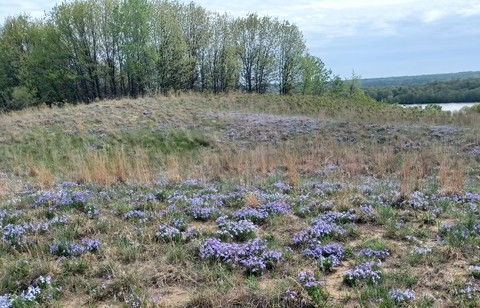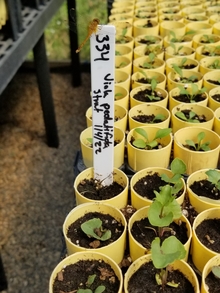Spring Lake Park Reserve in Dakota County was plowed farmland for decades before it became a park in the 1970s. But before European settlers came, forest, grasslands, wetlands, oak savanna and prairie unfolded upon its landscape.
Some of that original landscape still exists, even prairie “in remnants and tatters,” according to Joe Walton, senior ecologist for the park, which serves the public, as well as youth and community programs.
Dakota County is also the home base for Sam Talbot, a University of Minnesota Extension educator who is helping to reintroduce over 100 species of desirable native prairie plants, including the prairie violet.
The regal fritillary butterfly
“Like a large monarch dipped in chocolate,” Walton says, is how people sometimes describe the regal fritillary butterfly, which is listed as a species of special concern by the Minnesota Department of Natural Resources.
The fritillary family is named after the Latin word fritilus, meaning chessboard, for its checkered patterns.
The regal fritillary is known as a “prairie specialist.” It loves cruising the prairie, according to Walton. Flying over trees and brambles, not so much.
Small seeds, big challenge
Violets and butterflies may seem like light work after the park’s 2022 reintroduction of 2,000 lb. bison. But the goal is weighty: a whole prairie ecosystem restoration. Regal fritillary larvae must feed on the foliage of violets, specifically the native prairie violets, Viola pedata and Viola pedatifida. Those are in short supply.
Their life cycle is as nature intended but makes it tricky to collect the seeds they need for the park reserve. And timing is everything.
"It helps to know how violets nod their heads then stand upright before their three-part pods burst open to the sky like baby birds waiting for their worm,” says Walton. “The seeds are orange, but they are still hard to find after they fall to the ground, and then ants take them into their tunnels.”
With a little luck
A similar Three Rivers Parks project in Crow-Hassan Park Reserve served as a model to look to and learn from, but Dakota County needed to do several things differently to fit the unique landscape of Spring Lake Park Reserve and its own restoration goals.
For example, while it’s easy to source prairie violet seeds from other states, project partners wanted to collect from local sites, including Scientific and Natural Areas (SNAs), so they applied for a special permit to do so using conservation best practices, SNA site stewards and the help of local volunteers from Great River Greening.
Drought in 2020 and 2021 made seed collecting tough, but 2022 was a different story, especially at the Gray Cloud Dunes SNA in Cottage Grove and Lost Prairie SNA in Afton. “It was like they’d saved up their energy for this year,” says Walton. “So many flowers made a blue carpet across the knolls.”
Remarkably, volunteers collected nearly 90,000 seeds.
Improving germination
No matter how many seeds come in, germinating enough plants to bring back the regal fritillary butterfly is a tall order. That’s where Talbot comes in.
“I found that lightly sanding the seed coat and soaking seeds in a specific plant growth regulator not only increased germination rates but expedited the process,” says Talbot.
Talbot and Walton decided on a multi-faceted approach. Volunteers sowed some seeds directly into the prairie, while Talbot started others in propagation beds. Another batch of seeds will be grown in the greenhouse this coming spring with the help of volunteers.
“There is always uncertainty getting plants to establish, with weather and other factors, but I feel hopeful since we gathered so many seeds and Sam has been able to successfully grow them,” says Sara Nelson, who coordinated the seed-collecting efforts of the Great River Greening volunteers.
To see that chocolate-dipped butterfly flying over bison-grazed fields of flora and fauna, a glimpse of pre-settlement Minnesota, will be a most fanciful reward.
Contributors to the prairie violet project in Spring Lake Park Reserve include Dakota County parks and natural resources staff, Great River Greening, University of Minnesota Extension, Minnesota DNR Scientific and Natural Area Program, Carleton College, and Sherburne National Wildlife Refuge.
Funding support comes from the Environmental and Natural Resources Trust Fund, National Fish and Wildlife Foundation, and Dakota County.
Permission is granted to news media to republish our news articles with credit to University of Minnesota Extension. Images also may be republished; please check for specific photographer credits or limited use restrictions in the photo title.





